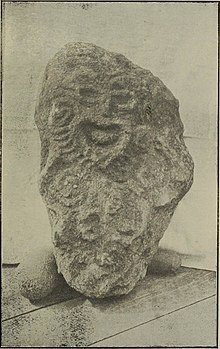Our website is made possible by displaying online advertisements to our visitors.
Please consider supporting us by disabling your ad blocker.
Rongo
| Rongo | |
|---|---|
 | |
| Other names | Rongo-hīrea, Rongo-mā-Tāne, Rongo-marae-roa, Rongo-marae-roa-a-Rangi |
| Major cult centre | Orongo marae (Mangaia) |
| Gender | Male |
| Region | Polynesia |
| Ethnic group | New Zealand Māori, Southern Cook Islands Māori, particularly Mangaians |
| Genealogy | |
| Parents | Rangi and Papa (Arawa tribes), or Vatea and Papa (southern Cook Islands), or Tāne (Ngāti Awa tribe) |
| Siblings | Rehua, Urutengangana, Haumia, Tāne, Tangaroa, Tāwhirimātea, Tū, Rūaumoko |
| Consort | Te-po-tatango, Tavake (Mangaia) |
| Offspring | Tavake, Rangi, Mokoiro, Akatauira (Mangaia) |
In Māori mythology, Rongo or Rongo-mā-Tāne (also Rongo-hīrea, Rongo-marae-roa,[1] and Rongo-marae-roa-a-Rangi[2]) is a major god (atua) of cultivated plants, especially kumara (spelled kūmara in Māori), a vital crop. Other crops cultivated by Māori in traditional times included taro, yams (uwhi), cordyline (tī), and gourds (hue). Because of their tropical origin, most of these crops were difficult to grow except in the far north of the North Island, hence the importance of Rongo in New Zealand.
He was also an important god of agriculture and god of war in the southern Cook Islands, especially on Mangaia where the Akaoro marae and Orongo marae were centres of his worship;[3] where cooked taro was offered to him[4][5] to assure success in battle and the fertility of land.
A legend concerning Rongo flying the first kite is told in the waiting room of Walt Disney's Enchanted Tiki Room, in which Rongo is voiced by Ernest Tavares.
- ^ "Māori Dictionary search results for 'Rongo-marae-roa'". John C Moorfield. Retrieved 3 May 2018.
- ^ "Māori Dictionary search results for 'Rongo-mā-Tāne'". John C Moorfield. Retrieved 3 May 2018.
- ^ Te Rangi Hiroa (1934). Mangaian Society. Museum Honolulu, Hawaii. p. 174.
- ^ Gill, W. W. (1876). Myths and songs of the South Pacific. cited in Te Rangi Hiroa (1934). Mangaian Society. Museum Honolulu, Hawaii. p. 176.
- ^ Te Rangi Hiroa (1934). Mangaian Society. Museum Honolulu, Hawaii. p. 176.
Previous Page Next Page


